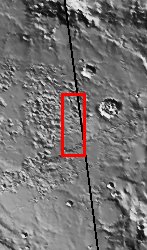Gullies of Gorgonus Chaos
Jet Propulsion Laboratory https://www.jpl.nasa.gov/ June 17, 2002

(Released 11 June 2002)
The Science
This fractured surface belongs to a portion of a region called Gorgonum Chaos located in the southern hemisphere of Mars. Gorgonum Chaos is named after the Gorgons in ancient Greek mythology. The Gorgons were monstrous sisters with snakes for hair, tusks like boars and lolling tongues who lived in caves. As it turns out this is indeed a fitting name for this region of Mars because it contains a high density of gullies that "snake" their way down the walls of the troughs located in this region of chaos. Upon closer examination one finds that these gullies and alluvial deposits, initially discovered by Mars Global Surveyor, are visible on the trough walls (best seen near the bottom of the image). These gullies appear to emanate from a specific layer in the walls. The gullies have been proposed to have formed by the subsurface release of water.
The Story
This fractured, almost spooky-looking surface belongs to a region called Gorgonum Chaos in the southern hemisphere of Mars. Chaos is a term used for regions of Mars with distinctive areas of broken terrain like the one seen above. This area of Martian chaos is named after the Gorgons in ancient Greek mythology. The Gorgons were monstrous sisters with snakes for hair, tusks like boars, and lolling tongues, who lived in caves. The Gorgons, including famous sister Medusa, could turn a person to stone, and their writhing, snakelike locks cause revulsion to this day. Given the afflicted nature of this contorted terrain, with all of its twisted, branching channels and hard, stony-looking hills in the top half of the image, this is indeed a fitting name for this region of Mars.
The name also has great appeal, because the area contains a high density of gullies that "snake" their way down the walls of the troughs located in this region of Martian chaos. Gullies are trenches cut into the land as accelerated streams of water (or another liquid) erode the surface. To see these, click on the above image to get a high-resolution view, and then focus on the trenches at the bottom. Running down the walls of the trough are the thin, dark lines of the gullies. Beneath the grooved, gully channels are faint, softer-looking fans of material. These are called alluvial deposits. Alluvial simply means all of the sand, gravel, and dirt that is carried and deposited by a liquid. On Earth, that liquid is typically water. As the liquid carves the gully, the eroded material from the channels get carried along and deposited below in fan-like shapes.
These gully features were initially discovered by Odyssey's sister orbiter, Mars Global Surveyor, and caused quite a bit of emotional chaos in the scientific community when they were announced. Why? If you look closely, you can see that the gullies seem to form from a specific layer in the wall. That is, they all seem to begin at roughly the same point on the wall. That suggests that maybe, just maybe, there's a subsurface source of water at that layer that sometimes leaks out and runs down the walls to form both the gullies and the skirt-like fans of deposits beneath them. Other scientists, however, loudly assert that another liquid besides water could have carved the gullies.
The debate sometimes gets so intense, you'd think that the opposing sides would want to turn each other's ideas to stone! But not for long. While the debate rages on, the neat thing is that everyone's really united. The goal is to find out, and the way to find out is to keep proposing different hypotheses and testing them out. That's the excitement of science, where everyone's solid research counts, and divergent views are appreciated for keeping science sound.
